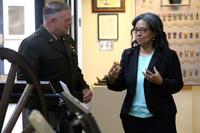Kicking down doors is high risk in the fight against terrorism because insurgents are likely to rig trap doors, tunnels or entry ways with lethal explosives, officials say.
The Explosive Ordnance Disposal Flight of the 96th Civil Engineer Group, the largest and busiest of all the service's EOD units, gave Military.com a glimpse into its standard training center during a recent tour at Eglin Air Force Base, Florida.
EOD techs may soon use lasers to dispose of explosive devices, said Chief Master Sgt. Christopher Schott, superintendent of Eglin's 96th Civil Engineer Group.
"The next step in our technology -- that's actually been proven, and we're just maturing it now -- is lasers," Schott said during a Nov. 17 interview.
"The problem of why it took so long to mature is the amount of wattage needed in a laser to disrupt an ordnance item causes so much heat, it required too much air conditioning," he said. "But they've got it down small enough now where the laser will disrupt an ordnance item and not require so much cooling."
The first place technicians intend to test it is during an air base recovery mode mission exercise, Schott said.
RELATED: Bomb Technicians Face Higher Risk in Iraq, Syria: Commander
The plan is to position the lasers "on top of an MRAP," or Mine-Resistant Ambush Protected vehicle, he said.
"We're finalizing the self-target part of [the lasers] where you don't have to zoom in and target each [IED], but [that] it will do that kind of for you," Schott said. "The longest part is burning through the ordnance, and the idea is to burn through the outer case of it, and get the inside to not detonate, but to burn out."
Robots, Biowarfare
The Air Force announced in May it's working with RE2 Robotics, which is developing a robotics system to inspect airfields for unexploded improvised explosive devices, or IEDs, under the service's rapid airfield damage repair program. RE2 told Air Force Times at the time that a future development would be for the robot to use lasers.
EOD airmen train constantly with robots, their associated controls, demolition tools, vests, helmets and bomb suits in the teams' less-fortified, stateside standby trailer.
RELATED: Air Force Bomb Squad to Protect Trump's Florida Mansion
Robots have only "just begun" to advance, made smaller to fit through doorways and climb stairs -- something EOD techs have wanted for quite some time, officials said.
But now that these advancements are here, the technological enhancements, especially for combat robots, have gone through the roof, "especially with portability," said Staff Sgt. Ryan Hoagland, 96th EOD Flight craftsman.
"We train with this as it would be in the real world," Hoagland said. "Deployed overseas, we generally have a different robot, and we work out of a much more armored vehicle."
Hoagland recalled deploying to Afghanistan, where he walked 150 miles with a portable robot on his back. The robot kept his team lead from having to work on an improvised explosive device manually, he said, “which is much more dangerous.”
The robots are still controlled "99 percent of the time" by an operator, Hoagland said.
And it will likely stay that way, Schott added, because there will always be too many variables in a live-action bomb disposal.
"We also have contingencies for weapons of mass destruction, and radiological or biological threats," Hoagland said.
EOD teams train twice a year to react to the lethal, banned warfare, but have no plans to increase training despite reports the Islamic State has used mustard gas agents against civilians and coalition troops in Syria in recent months, he said.
"It doesn't seem to be a large concern of ours right now," Hoagland said.
"Being part of the test mission here has presented some unique challenges," Hoagland said. "We develop new procedures that get passed out to … all of the EOD career fields, whether it's Air Force, Army, Navy or Marines."
Bombing Ranges
Unexpected projects also keep the EOD techs busy.
In October, teams used large remote control excavators to hunt for an unexploded bomb on one of the Air Force's many Florida testing ranges, Hoagland said.
Three out of 12 bombs dropped during exercises didn't detonate, he said.
The team made it down roughly 60 feet, but Hoagland assured it is "down there."









